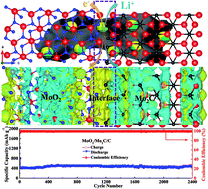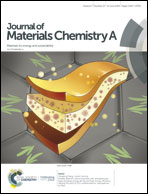One-pot synthesized molybdenum dioxide–molybdenum carbide heterostructures coupled with 3D holey carbon nanosheets for highly efficient and ultrastable cycling lithium-ion storage†
Abstract
The molybdenum dioxide (MoO2)–molybdenum carbide (Mo2C) heterostructures were built by in situ forming the (100) plane of Mo2C nanoparticles along the (101) plane of MoO2 nanoparticles and were simultaneously anchored on a 3D holey carbon substrate via optimized annealing of the bio-inspired ammonium molybdate tetrahydrate-agar gel. Both experimental results and theoretical simulations demonstrated the important roles of wide interfaces between MoO2 and Mo2C in improving the electrochemical performance of MoO2-based electrodes. These uniquely prepared MoO2/Mo2C/C electrodes delivered a capacity of 845.2 mA h g−1 at 0.1 A g−1 after 200 cycles, with a capacity change rate of 2.3%, overcoming the key obstacle for commercial application of transition metal oxides caused by capacity changes during the cycling process. Meanwhile, the electrodes displayed ultrastable long cycling performance with a capacity of 507.3 mA h g−1 at a high current density of 1.0 A g−1 after 2400 cycles, still far higher than the theoretical capacity of carbon materials. Both a local in-built driving force in the electrodes and synergistically induced more efficient mass transport across the interface were predicted by the Density Functional Theory (DFT) and Density of States (DOS) calculations from the formed interfacial electric field, yielding the fast reaction kinetics and outstanding lithium storage ability. This work highlights an efficient strategy to obtain ultrastable long cycling performance and also excellent electrochemical performance of MoO2-based materials and other transition metal oxides as anodes for lithium ion batteries. In addition, the full batteries based on MoO2/Mo2C/C anodes and a commercial LiCoO2 cathode present stable cycling performance.

- This article is part of the themed collection: 2019 Journal of Materials Chemistry A Most Popular Articles


 Please wait while we load your content...
Please wait while we load your content...